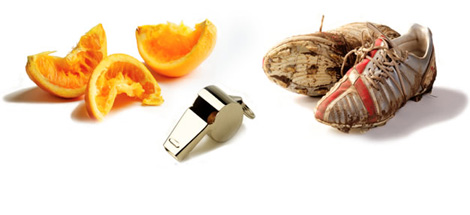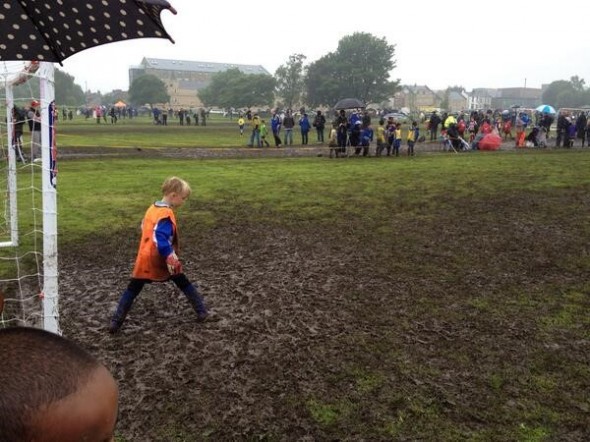In the last year over 100,000 people have walked away from grassroots football.

The England squad in Rio de Janeiro at the moment may be seeing the emergence of talented youth players such as Sterling, Lallana and Barkley – but can this develop into a continuous trend without the next generation of players coming through in full capacity?
Many believe that much of the nation’s potential footballing talent is being blocked from ever making it to the professional level because many youth and amateur players simply cannot afford to keep turning up.
The game that was once a great outlet for the working classes that catapulted the likes of Paul Gascoigne, Ian Wright and Wayne Rooney from terraced streets and Sunday league parks to the international stage is rapidly becoming the preserve of only the well-off, according to groups active in trying to rescue what they see as a game in crisis.
Another strong argument is that conditions and amenities are making your average Sunday league grounds increasingly unpalatable to young people who, with a certain video game, would understandably rather score goals in their living rooms without having to change out of their pyjamas.
This makes for quite an imposing dilemma for those involved in trying to improve the state of the game at this level.
David Crausby MP, the head of the Save Grassroots Football campaign said recently:
 “Poor pitches, weeks of play lost to bad weather, no changing facilities, no showers, increasing pitch fees, poor families priced out and other families deterred by the shoddy conditions…The result is not surprisingly that participation is falling. There are currently 1.84 million people playing football on a regular basis, according to Sport England, a fall of 100,000 since April last year. There were more than two million people playing in 2006 and what we are witnessing is a long-term decline.”
“Poor pitches, weeks of play lost to bad weather, no changing facilities, no showers, increasing pitch fees, poor families priced out and other families deterred by the shoddy conditions…The result is not surprisingly that participation is falling. There are currently 1.84 million people playing football on a regular basis, according to Sport England, a fall of 100,000 since April last year. There were more than two million people playing in 2006 and what we are witnessing is a long-term decline.”
A recent survey of over two and a half thousand people showed that a lack of support from local authorities was top of respondents’ concerns. The Knock-on effect of which is an inability to cope with what should be a minor obstacle such as rain – which not only stops play in an immediate sense but leads to a slow degeneration of pitches, facilities and ultimately player enthusiasm – not to mention the standard of play.
One solution put forward recently by minister for sport and tourism, Helen Grant, is to increase the number of third generation or “3G” pitches that eliminate the problem of waterlogged or unplayable surfaces, which considering the level of flooding in Britain in recent winters, is certainly a worthy option.

Helen Grant MP, wants to increase the number of 3g pitches.
Of course, any improvements such as these come at a cost, which many councils just do not have the funds to cover – or at least they see the issue as a low priority.
But should it be? With obesity and its related health issues becoming so prevalent, shouldn’t we be doing more to encourage people to get out and do a bit of exercise?
One twitter user expresses his opinion through sardonic humour: “Today that’s just the under 6s through 9s. Tomorrow it’s under 10s through 12s on the same pitches. #hoof.”

How Can I help?
You can support the @savegrassroots twitter campaign.
You can also get involved with non league day, a fantastic day dedicated to grassroots football. Click here to see how Discount Football Kits helped non league day last year.
To help improve the standard of coaching at your club you can click here for the free training drills brought to you by Louis Lancaster a level 5 coach, in association with Discount Football Kits.
Or you can vote and comment below to let us know your thoughts on what the biggest challenges facing grassroots football are.
[poll id=”16″]










Great and interesting article. I feel it also difficult to find venues/pitches available to play football but I managed to find this site which has been a massive help to me.
http://mylocalpitch.com/
As a junior club we have managed to build up a fund of several thousand pounds to get some drainage work done to council owned pitches we play on, but have had nothing but blockers from the local authority in trying to get anything done. If we want to engage the contractors we have to get the council to issue us a licence and cover their surveyor and legal costs which would run to at least £500 (more than the initial 1 day investigation we wanted to take place). Eventually they have agreed to engage the contractor themselves with us… Read more »
Hi, I am the secretary and founder of my junior football club Lisbon St. Anthony’s. The problems we are having is the cost of new posts and pitches. A few years back we had teams up to the age of 17 now our eldest team is 13.When they got to 11 they had to move from the school we are based at to the local park where the pitches were for open age players so obviously they were massive compared to what they were playing on plus they were full of dog dirt. The lads and parents got fed up… Read more »
My U12’s lost 8 wks of games last season because of waterlogged pitches, the ironic thing is we trained on astroturf pitches when the matches were called off. 3g pitches are the future of grassroots football. As regards cost the FA and Government must play their part in funding. If this situation carries on I foresee in l0 yrs grassroot teams will be so reduced, we may have leagues to play in.
I have been coaching 10 years now and last year started coaching girls football in Eastbourne, East Sussex. We started with just 10 girls and now have 60 girls playing football. However lack of facilities, training and match venues is severely restricting our progress. There is also a severe lack of interest from local councils in assisting with girls, especially the older age groups requiring access to toilet and changing facilities. The too difficult light shines brightly.
This is not just one thing. Firstly grass roots football is what it says on the tin.At the end of the day It’s not about elitist academies it’s about boys and girls who want to play at any standard. Good players move on to academies and this should be encouraged but we should not forget those who just want to play Lack of parents to get involved is an issue as most just want to turn up and watch then go home. Young families lead busy lives nowadays and time with them becomes increasingly precious. Facilities are an issue. My… Read more »
Perhaps if children were given more encouragement to play in School teams, Inter-District Schools Football teams, County Schools Football teams, then they would be more interested in playing the game.
I was involved with Football Futures for over 5 years. We played on good pitches at Burford Road Playing fields in Oscott Ward. This year the education department has decided that they cannot afford to cut the grass. Savings – approx £1200. Many local kids use the field for recreational footy and Football Futures use it ine football season. There are no other pitches close by that the local people can get to. We are in a deprived area and yet again the local authorities talk about exercise, obesity levels and keeping kids away from computers, but in real terms… Read more »
The FA don’t help either, FA ruling,Sunday league football, the referee’s are only allowed to officiate in black, if this clashes with a team colour, that team has to change strip. Yet in the Premier league we see week in week out the referee’s in all sorts of different colours, the cost of one shirt as opposed to an entire team strip.
Surely that comes under the heading of discrimination!!!!!!!